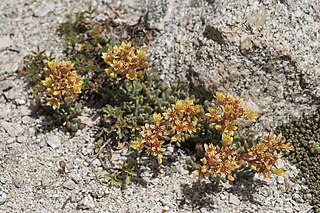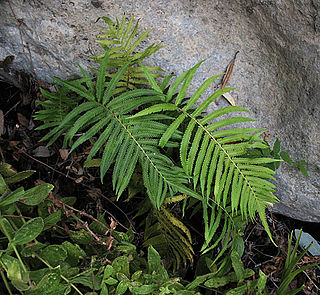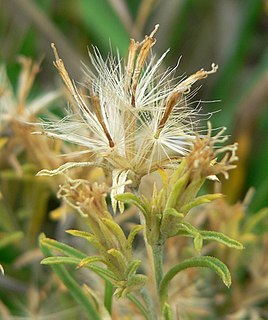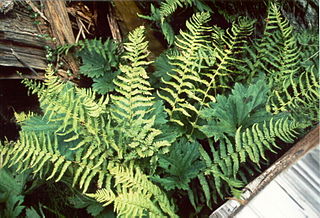
Cupressus arizonica, the Arizona cypress, is a North American species of tree in the cypress family Cupressaceae, native to the southwestern United States and Mexico. Populations may be scattered rather than in large, dense stands.

Thelypteris is a genus of ferns in the subfamily Thelypteridoideae, family Thelypteridaceae, order Polypodiales. Two radically different circumscriptions of the genus are in use as of January 2020. In the Pteridophyte Phylogeny Group classification of 2016, the genus is a very small one with about two species. In other approaches, the genus is the only one in the subfamily Thelypteridoideae, and so includes between 875 and 1083 species.

Chaenactis nevadensis, with the common name Nevada dustymaiden, is a North American species of flowering plant in the daisy family.

Thelypteris palustris, the marsh fern, or eastern marsh fern, is a species of fern native to eastern North America and across Eurasia. It prefers to grow in marshy situations in full sun. The species epithet palustris is Latin for "of the marsh" and indicates its common habitat. It is the only known host plant for Fagitana littera, the marsh fern moth.
Podistera nevadensis is an uncommon species of flowering plant in the carrot family known by the common names Sierra podistera and Nevada podistera.

Pyrrocoma lucida is a species of flowering plant in the family Asteraceae known by the common names sticky goldenweed and sticky pyrrocoma. It is endemic to California, where it is known only from the northern Sierra Nevada. It grows in mountain forests and clay flats with alkali soils. This is a perennial herb growing from a taproot, producing an erect stem up to 75 centimetres (30 in) tall. It is hairless and glandular, its surface resinous and shiny. The leaves are lance-shaped with sharply toothed edges, the largest near the base of the stem reaching 25 centimetres (10 in) in length. Smaller leaves up to 10 centimetres (4 in) long occur higher on the stem. The inflorescence is a narrow spikelike array of many flower heads lined with thick, overlapping, gland-dotted phyllaries. Each head contains up to 40 yellow disc florets surrounded by a fringe of up to 20 yellow ray florets. The fruit is an achene up to a centimeter long including its pappus.

Rudbeckia californica is a species of flowering plant in the family Asteraceae, known by the common name California coneflower.

Sedum obtusatum is a species of flowering plant in the family Crassulaceae known by the common name Sierra stonecrop. It is native to the Sierra Nevada and adjacent high mountain ranges of California, its distribution extending north into Oregon and east into Nevada. It grows in rocky mountain habitat.
Sedum radiatum is a species of flowering plant in the family Crassulaceae known by the common name Coast Range stonecrop. It is native to Oregon and California, where it is known from several coastal and inland mountain ranges, including the Klamath Mountains and the Sierra Nevada. It grows in many types of rocky habitat, sometimes on serpentine soils. It is an annual or biennial succulent plant producing several stems with elevated, somewhat basal rosettes of leaves. The leaves are not much more than a centimeter long. They are green or yellowish with green, purple or red veining. The inflorescence is a short, erect array of many densely packed flowers. The flowers have yellow, cream, or white petals which are lance-shaped and one half to 1 centimeter long.

Acleisanthes nevadensis is a species of flowering plant in the four o'clock family known by the common names desert moonpod and desert wing-fruit. It is native to a section of the southwestern United States encompassing southern Nevada and adjacent corners of Utah and Arizona. One occurrence has been observed in eastern California. The plant grows in desert habitat such as scrub and rocky washes. This herb produces several spreading stems up to about 30 centimeters in maximum length, sometimes from a woody base. The stems are covered in many leaves with fleshy oval or rounded blades up to 3 centimeters long which are borne on petioles. The herbage of the plant is coated in thick, wide, white, furry hairs, interspersed with shorter, flat hairs. Some hairs are glandular. Flowers occur in leaf axils. Each is a trumpet-shaped bloom with a narrow, tubular green throat up to 4 centimeters long and a round white corolla face about a centimeter wide, sometimes tinged yellow or greenish. There are five long, protruding stamens and a long style tipped with a spherical stigma. The fruit is a ribbed, hairy body with five broad, white wings.

Sidalcea oregana is a species of flowering plant in the mallow family known by the common name Oregon checkerbloom.

Silene occidentalis is a species of flowering plant in the family Caryophyllaceae known by the common names western catchfly and western campion.

Streptanthus tortuosus is a biennial or short lived perennial plant in the mustard family (Brassicaceae) known by the common names shieldplant, shieldleaf, and mountain jewelflower.

Christella puberula, synonym Thelypteris puberula, is a species of fern known by the common name showy maiden fern. The variety Ch. puberula var. sonorensis is known by the common name Sonoran maiden fern.
Goniopteris verecunda, synonym Thelypteris verecunda, is a rare species of fern known by the common name Barrio Charcas maiden fern. It is endemic to Puerto Rico, where it is known from only three localities. It is a federally listed endangered species of the United States.

Cupressus nevadensis, now reclassified as Hesperocyparis nevadensis, with the common name Paiute cypress, is a species of cypress tree native to a small area in Sierra Nevada of California, in the western United States.

Ericameria parryi is a species of flowering plant in the family Asteraceae known by the common name Parry's rabbitbrush. It is native to much of the western United States.

Coryphopteris simulata, synonym Thelypteris simulata, is a species of fern native to the Northeastern United States. It is known by two common names: bog-fern and Massachusetts fern. It is often confused with the silvery spleenwort, New York fern, and the marsh fern due to similarities in shape and size.

Parathelypteris is a genus of ferns in the family Thelypteridaceae, subfamily Thelypteridoideae, in the Pteridophyte Phylogeny Group classification of 2016. Other sources sink Parathelypteris into a very broadly defined genus Thelypteris.
















